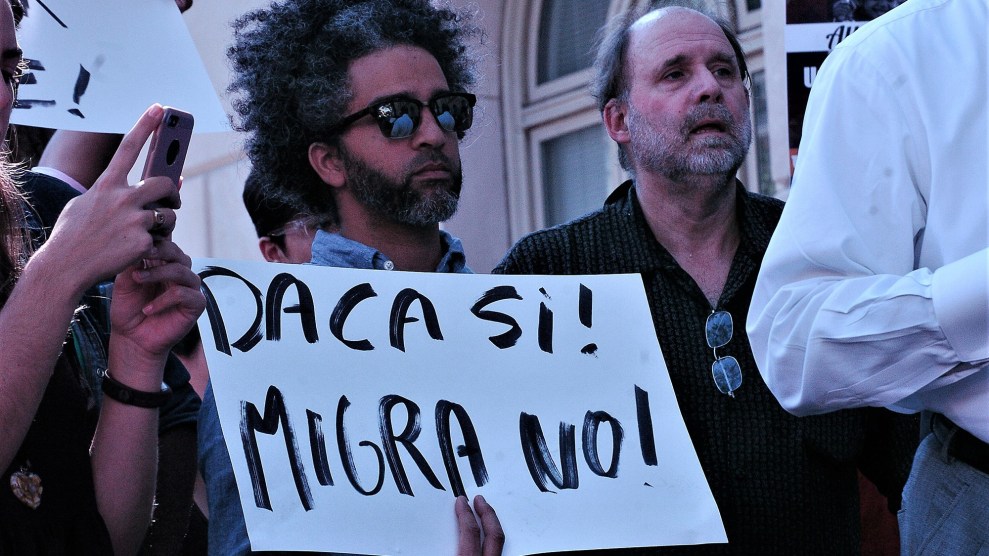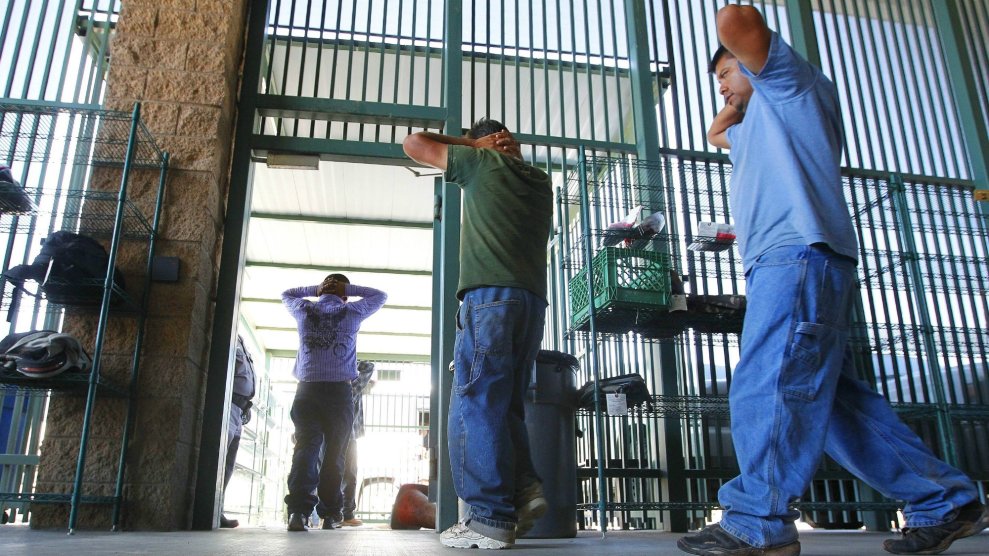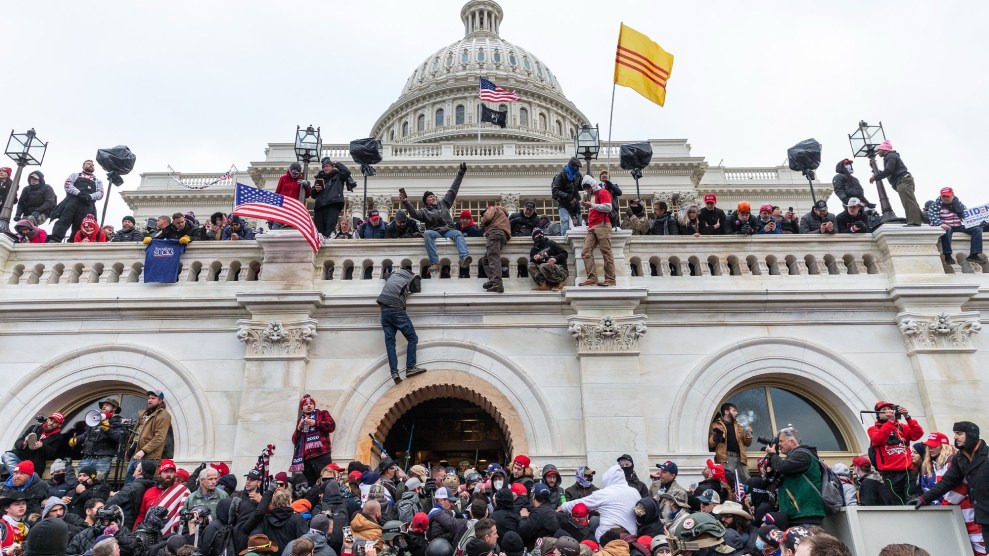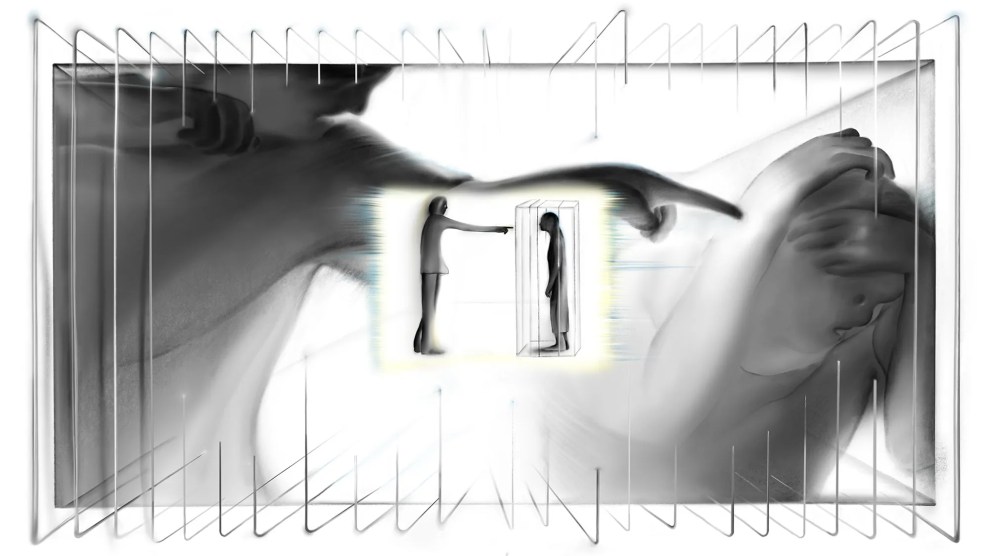
DACA recipients, friends, families and allies rally at the Department of Justice offices in Philadelphia on Sept. 5, 2017. Cory Clark/NurPhoto/Sipa USA/AP
This story was originally co-published by The Philadelphia Inquirer and ProPublica.
When immigration officers raided a rural Pennsylvania poultry transport company early last year, a lawyer for five undocumented men arrested saw plenty of evidence their rights had been violated.
The Immigration and Customs Enforcement officers had no warrant to drive past the company’s “No Trespassing” signs and block the exits with their vans, or to demand documentation on the workers’ legal status. According to witnesses, the officers seemed to target workers solely based on their ethnicity: They lined up Latinos for questioning and asked white employees to lead them to more Latino workers.
In a ruling last month, a Philadelphia immigration judge, John Carle, found there was a strong argument that the ICE officers had “egregiously violated” the Constitution. He noted that the agency presented no evidence to counter allegations of racial profiling.
If the case had played out in criminal court, such a finding might well have resulted in the men going free.
In immigration courts, however, there’s a higher bar, both for proving officers violated defendants’ rights and for getting cases thrown out as a result. Even when immigrants manage to meet this standard, they can get deported anyway.
The system is backed up by decades-old court rulings that consider undocumented immigrants to be in continuous violation of the law, regardless of how they are arrested, and that give officers extra latitude to factor in their targets’ physical appearance when making immigration arrests.
“Even if you were to suppress the evidence because you didn’t have proper consent … that doesn’t matter,” said Claude Arnold, a former ICE special agent. “The fact remains that the person is here illegally.”
ICE says its agents are forbidden from racial profiling, and are refreshed on training every six months.
But advocates for immigrants and some judges say that the logic governing immigration rulings only emboldens officers to trample over constitutional rights.
“It gives a huge incentive to do intentionally illegal searches, because they have a huge way to take advantage of it,” said Rex Chen, an attorney at Safe Passages Project.
In the case involving the Lancaster County poultry workers, the racial-profiling argument has done little to derail ICE’s deportation efforts.
After arresting the workers, ICE officials looked them up in a database and found that four of them had overstayed their visas. Since this information did not stem from their arrests, but was obtained separately, Carle decided their deportation cases could proceed.
“All they did instead was basically almost say, ‘Nanny-nanny, boo-boo, we got you anyway,’” said Simon Sandoval-Moshenberg, a lawyer at the Legal Aid Justice Center who has worked on similar cases. “Like, so what if we violated constitutional rights? We have this other piece of evidence, and that’s it, you’re done for.”
It’s Harder for Immigrants to Prove an Unlawful Search
Unlike criminal defendants, immigrants must demonstrate not only that officers acted unconstitutionally, but that their violations were egregious, or represented a widespread pattern, when filing a motion to suppress evidence as the poultry workers did.
This higher bar dates back to Supreme Court guidance from 1984, when the court concluded that allowing motions to suppress in deportation cases would compel courts to release people who would then “immediately resume their commission of a crime through their continuing, unlawful presence in this country.”
At the time, almost all of those arrested for immigration violations agreed to leave the country without a formal hearing, the justices wrote, so challenges to the legality of immigration officers’ actions virtually never came up and wouldn’t deter them.
The justices also trusted that the U.S. Immigration and Naturalization Service, the precursor to ICE, had “its own comprehensive scheme for deterring Fourth Amendment violations by its agents.”
Its conclusions “might change,” the justices wrote, “if there developed good reason to believe that Fourth Amendment violations by INS officers were widespread.”
A lot has changed since then. After the terrorist attacks of Sept. 11, 2001, immigration enforcement moved under the Department of Homeland Security and greatly widened in scope. Now, most immigrants choose to fight their deportations, as the mammoth 680,000-plus case backlog can attest.
Accusations of racial profiling abound—committed by cops on highways, Border Patrol agents on buses and ICE on neighborhood streets—though motions to suppress are still rare and filed by the most aggressive lawyers.
Few cases will have enough evidence to prove an egregious violation.
“The best indicators of racial profiling are comments,” said Sandoval-Moshenberg. “We have one case in which the ICE agent said, ‘Hey, are any other Spanish families living on the block?’ … Otherwise, it’s very difficult to prove racial profiling. The officer always has some other reason on why he stopped your client and no one else.”
One of those reasons could legitimately be “Mexican appearance,” thanks to another Supreme Court ruling.
In that 1975 case, a U.S. citizen of Puerto Rican descent was stopped by Border Patrol agents. Two undocumented people were passengers in the car. The agents said their only reason for the stop was that the car’s occupants looked Mexican.
The court found that “Mexican appearance” alone could not justify an immigration stop, but ruled that a list of examples, used together, could. They included: “characteristic appearance of persons who live in Mexico, relying on such factors as the mode of dress and haircut”; “facts in light of [the officer’s] experience in detecting illegal entry and smuggling”; “driver’s behavior,” such as “erratic driving” or “obvious attempts to evade officers”; and “characteristics of the area in which they encounter a vehicle.”
“All those give an awful lot of discretion to rely on race,” said Kevin R. Johnson, a law professor at University of California-Davis. “Even if they say, ‘Well, he’s wearing working clothes’ or ‘He’s wearing clothes typical of an immigrant from Mexico,’ or something like that, there’s an awful lot of leeway there.”
When confronted with public outcry about profiling, ICE and the Border Patrol usually respond that agents used “a multitude of indicators that, when put together, raise a reasonable suspicion of illegal alienage.”
For example, in an Oregon case caught on video by a legal observer for the ACLU of Oregon last year, Isidro Andrade-Taffolla, a U.S. citizen, alleged racial profiling after he was questioned as he left a county courthouse. ICE officers in plainclothes had approached him with a picture of another man and asked for his identification, but Andrade-Taffolla said the picture looked nothing like him except for his skin color.
ICE officials said the questioning was in line with their policies. “Physical appearance wasn’t the only thing in common between the person questioned and the actual target,” Matthew Bourke, a spokesman for ICE, told ProPublica. “ICE officers had information that the target would be at the courthouse, and that—combined with a similar physical match—was why ICE officers asked for identification.”
Peter Schuck, a Yale law professor, argues that some reliance on profiling may be necessary for officers to act quickly and efficiently.
“It’s hard to see how immigration enforcement could occur without some kind of stereotyping and generalization,” he said. “It stands to reason that they don’t know much about the people they are seeking, so they have to rely on inferences, and those inferences are generally supported by some stereotypes.”
Arnold, the former ICE agent, said officers use observations about a person’s “manner and demeanor” to assess whether they could be here illegally. According to him, these can include noticing when people speak only Spanish or appear nervous when encountered by an immigration officer.
“Maybe a bunch of people are running,” he said. “Maybe the five white employees are just standing there; they aren’t running. It has nothing to do with their skin color, but I know clearly they are not afraid of ICE. … That is an indicator to me that they might be legal.”
Proving Profiling May Not Be Enough to Get an Arrest Tossed
ProPublica and the Philadelphia Inquirer reported on the Lancaster County poultry workers’ arrest in a series this spring about ICE’s aggressive enforcement in Pennsylvania, an effort not completely supported by local communities.
Luke Brubaker, a prominent dairy farmer, mentioned the workers’ arrest in a meeting between President Trump and agriculture-industry representatives. Brubaker said he told the president that ICE had been arresting essential workers in Pennsylvania agriculture.
According to the workers’ motion to suppress evidence, filed in October, ICE officers came onto the property on April 5, 2017, with a photo of a man they were looking for. His name was “Alix,” and he worked for a company called MainJoy Unlimited.
Workers told them they were at the wrong company, and nobody with that name worked there. But agents immediately moved to ask for the documents of the workers who did.
“They were totally taking advantage of the language barrier and the fact that these guys didn’t know they had any rights,” Nichole Carpenter, the company’s human resources manager, told a reporter. “The three mechanics in the mechanic’s bay—white guys in their 50s—just continued to work like nothing was going on.”
Under duress, the Latino poultry workers admitted to being undocumented.
ICE used those admissions, and the workers’ lack of documentation at the time of the arrest, to try to get them deported. The men asked the judge to prohibit ICE from using that evidence, arguing they were intimidated and coercively interrogated because of their race.
They added, in the motion, that an officer physically forced one of them to sign papers and get fingerprinted. They also said an officer told them they had come to the United States to “take his jobs and invade his country.”
In December, ICE voluntarily withdrew the evidence gathered from the arrests of four of the men, saying it had found independent proof in a database that they were in the country illegally because they’d overstayed short-term visas.
The Philadelphia judge made his preliminary ruling on the motion to suppress only for the one man without a trail in the database. ICE had no record of him, presumably because he entered the country illegally. The ICE officer who ran his background check had simply written “no criminal history” and, crucially, “no migration history” on his intake form.
In court documents, ICE called the interrogation “consensual.” But the judge found that there was enough evidence to suggest ICE officers had detained him because he was “Latino-looking.” He ruled that ICE would have to prove otherwise or drop its case. If ICE decides to fight the allegations, it will do so at a hearing in October.
The judge allowed deportation proceedings to go forward against the four workers in the database. The men are out of custody, on bond, and plan to appeal Carle’s decision.
“It’s a weird situation,” said Andy Mahon, the lawyer for the workers. “Because they did things the ‘right way,’”—entered the country legally—”they are in a worse position than someone who didn’t, because now that evidence is being used against them.”
The agency declined to comment on the case, other than to say: “ICE’s enforcement actions are targeted and lead driven. ICE does not conduct sweeps or raids that target aliens indiscriminately.”
Arnold said that even if an immigrant proves an ICE officer searched him without cause or consent, it still doesn’t negate being here illegally. “The court can’t remedy that and say, ‘OK, yeah, we’ll make that person legal.’ How do they do that? The court does not have the authority,” he said.
Over the years, some judges have questioned the Supreme Court’s reasoning, seeing outcomes like this as encouragement for ICE officers to overstep in their operations, in hopes that they’ll be able to net enough deportable people.
In August 2017, the 9th Circuit in California reviewed the case of Luis Enrique Sanchez, a 45-year-old undocumented immigrant who had lived for almost three decades in California. A small boat owner, he took his friends out for a ride off Channel Islands Harbor, within territorial waters. When his boat’s engine lost power, he called the Coast Guard for help. The Coast Guard rescued the group—then immediately detained and frisked Sanchez and his friends and reported them to ICE.
When Sanchez filed a motion to suppress, ICE also found him in a database that showed his legal status had lapsed.
Unlike Judge Carle, the 9th Circuit ruled that his deportation case should be dropped. Doing otherwise “allows immigration and other law enforcement agencies to prey on migrant and working-class communities. Law enforcement officers can unconstitutionally round up migrant-looking individuals, elicit their names, and then search through government databases to discover incriminating information in preexisting immigration records,” one judge wrote.
While lower courts have issued conflicting rulings, the Supreme Court hasn’t weighed in to clarify since the 1980s, leaving the issue unsettled until the court decides to intervene again.
It’s Impossible to Tell When or if Officers Get Disciplined
ICE and Border Patrol say they investigate complaints of rights violations, including profiling, but it’s unclear what this amounts to.
Both agencies declined to release numbers on how many officers, if any, had been disciplined for racial profiling in recent years.
The Department of Homeland Security’s Office of Inspector General, which looks into complaints about immigration agencies, has never issued a report on racial profiling. Complaints and internal investigations are never aired in public.
Arnold said ICE officers are deterred from making illegal searches by the threat of lawsuits. But advocates say the system is set up to make officers feel as if they won’t face consequences for inappropriate behavior.
The lawyer for the poultry workers said he has not filed a complaint about the officers’ behavior. Like many immigration lawyers, his priority is to keep the workers in the country. He doesn’t see any benefit for his clients in complaining to the department.
“There’s next to no accountability, ” said Sandoval-Moshenberg, who has made the same decision in similar cases. “Our perception of their internal complaint mechanism is that it’s totally broken and ineffective.”
ProPublica is a Pulitzer Prize-winning investigative newsroom. Sign up for their newsletter.














